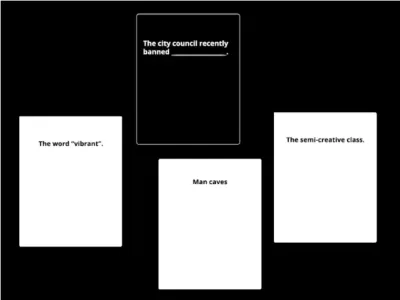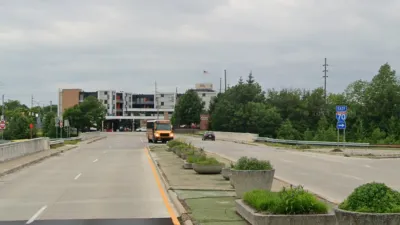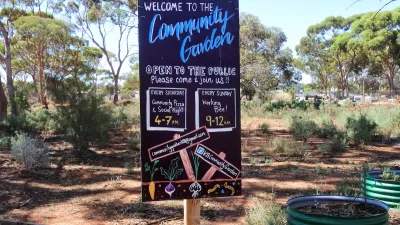Reflection on the education provided by the irreverent game called Cards Against Urbanity has led the game's creators to create a new, less snarky version of the game.

The game has proven popular enough (indeed, the news post announcing the creation of the game was the sixth most popular news story on Planetizen in 2014), that "the team behind the card game is launching a new, more serious stack of cards. Call it, if you wish, Cards For Urbanity," according to Kaufman.
"Imagine, Do Tank and Greater Places say, a Pinterest board of urban planning — but in real life. Each card will have a single concept or buzzword on it — a woonerf or a protected bike lane or sneckdown — along with an illustration and a definition. The cards are remixable and rearrangable, of course, and the team thinks everyone can use these."
Kaufman provides a lot more about the thinking behind a less snarky version of the game, especially its potential to benefit planning processes around the country. The news about the new card game comes at the one-year anniversary of the Cards Against Urbanity game.
FULL STORY: How a Not-Entirely-Polite Card Game Is Changing Urban Planning

Planetizen Federal Action Tracker
A weekly monitor of how Trump’s orders and actions are impacting planners and planning in America.

Congressman Proposes Bill to Rename DC Metro “Trump Train”
The Make Autorail Great Again Act would withhold federal funding to the system until the Washington Metropolitan Area Transit Authority (WMATA), rebrands as the Washington Metropolitan Authority for Greater Access (WMAGA).

The Simple Legislative Tool Transforming Vacant Downtowns
In California, Michigan and Georgia, an easy win is bringing dollars — and delight — back to city centers.

Albuquerque’s Microtransit: A Planner’s Answer to Food Access Gaps
New microtransit vans in Albuquerque aim to close food access gaps by linking low-income areas to grocery stores, cutting travel times by 30 percent and offering planners a scalable model for equity-focused transit.

This City Will Pay You to Meet Your Neighbors
A North Kansas City grant program offers up to $400 for residents to throw neighborhood block parties.

Commentary: Our Silence Will Not Protect Us
Keeping our heads down and our language inoffensive is not the right response to the times we’re in. Solidarity and courage is.
Urban Design for Planners 1: Software Tools
This six-course series explores essential urban design concepts using open source software and equips planners with the tools they need to participate fully in the urban design process.
Planning for Universal Design
Learn the tools for implementing Universal Design in planning regulations.
Smith Gee Studio
City of Charlotte
City of Camden Redevelopment Agency
City of Astoria
Transportation Research & Education Center (TREC) at Portland State University
US High Speed Rail Association
City of Camden Redevelopment Agency
Municipality of Princeton (NJ)





























